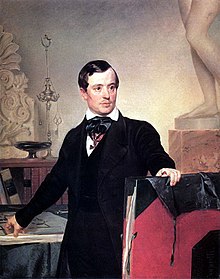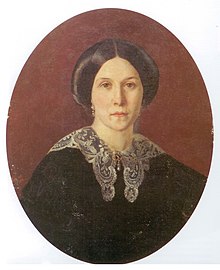Alexander Pavlovich Brjullow

Alexander Pavlovich Bryullov ( Brulleau to 1822) ( Russian Александр Павлович Брюллов ; born November 29 . Jul / 10. December 1798 greg. In St. Petersburg , † January 21 . Jul / 2. February 1877 . Greg ) was a Russian Watercolor artist , architect and university professor .
Life
Brjullow, son of the plasterer and miniature painter Paul Brulleau , was admitted to the Academy of Arts in 1809 together with his younger brother Karl for education at state expense . Alexander Brjullow studied in the architecture class (1810-1820), which he graduated with honors. His teachers were Andrejan Sacharow , Andrei Voronichin and Andrei Alexejewitsch Michailow .
In 1822, the two brothers traveled to Munich on a six-year scholarship from the Imperial Society for the Promotion of the Arts , and then to Rome in May 1923 . Alexander Bryullov studied the ancient ruins there with devotion . He painted the Roman Coliseum for Empress Marija . Together with Alexander Lwow , he visited Sicily in 1824 and then Pompeii , where he began the graphic reconstruction of the thermal baths . In Naples he created watercolor portraits of the royal family. He also portrayed Ioannis Kapodistrias and Natalja Puschkina-Lanskaja .
In 1826 Brjullow went to Paris with the finished drawings , where his Pompeian drawings appeared as graphics , while the French text was not printed until 1829. He studied mechanics and architectural history at the University of Paris . He visited Chartres and other cities in England . In 1830 he returned to St. Petersburg. Thanks to his Pompeian Baths , he became His Majesty's Architect , Corresponding Member of the French Institute, Member of the Royal Institute of British Architects and Member of the Academy of Arts in St. Petersburg and the Accademia di Belle Arti di Brera . In 1830 he exhibited a watercolor portrait of Prince Pyotr Lopukhin , and in 1931 he portrayed Emperor Nicholas I , surrounded by cadets from the various corps .
As an architect, Brjullow became known for his buildings in St. Petersburg and the surrounding area. 1831-1832 he built the St. Petersburg Mikhailovsky Theater, the neo-Gothic Peter and Paul Church in Pargolowo for Countess Varvara Petrovna Shuwalova and the house of Countess Samoilova in Slavyanka and the Lutheran Church of St. Peter on Nevsky Prospect . In the same year he was appointed professor of architecture for his project of a magnificent church in the classical style.
1835–1839 Brjullow also carried out projects in the province, for example an obelisk in Tobolsk in memory of the battle of the Cossacks under Ataman Yermak Timofejewitsch against the Tatars under Kütschüm Khan . In 1837 he created a portrait of Walter Scott in Paris , which he transferred onto stone. His great talent was shown in the restoration of the living quarters of the Winter Palace after the fire in 1837 and the construction of the parade house . The palace gallery with Pompeian ornaments was a particular success . He also built the Pulkovo Observatory on the Pulkovo Heights on the highest orders from 1834-1839 , which he built at the same time as the Guard Corps headquarters building on Palace Square in St. Petersburg (1837-1843). In 1842 he planned and built the caravanserai in Orenburg with a mosque and minaret . This was followed by the renovation of the marble palace for the wedding of Grand Duke Konstantin Nikolajewitsch in 1848, in which Peter Clodt von Jürgensburg took part. For SD Netschajew he built the Kulikowo Column (1848-1850) to commemorate the battle on the Kulikowo Pole .
Bryullov taught at the Academy of Arts. In 1842 he was appointed professor first class and in 1854 an honored professor . Because of conflicts with Emperor Alexander II , he had to forego active building work. He was often commissioned with scientific and technical reports. In 1871 he retired, but remained a member of the Academy Council.
Brjullow had been married to Baroness Alexandra Alexandrovna von Rall (1810–1885), daughter of the German-Russian banker Baron Alexander Franz von Rall and his wife Jelisaweta Nikolajewna née Molwo (1768–1843, daughter of the sugar manufacturer Hermann Nikolaus Molwo) and sister-in-law of Writer Ossip Julian Iwanowitsch Senkowski and General Friedrich Schubert . The couple had nine children, of whom the eldest three sons and one daughter died in childhood. Karl Brjullow, Mikhail Glinka , Nestor Kukolnik , Nikolai Gogol and Fyodor Jordan frequented her house and dacha in Pavlovsk . Alexandra Alexandrovna, a talented musician, conducted music evenings .
Bryullov was buried in the Pavlovsk city cemetery.
Works
Web links
Individual evidence
- ^ Article Brjullow Alexander Pavlovich in the Great Soviet Encyclopedia (BSE) , 3rd edition 1969–1978 (Russian)
- ↑ a b c d e f g Прогулки по Санкт-Петербургу: Брюллов Александр Павлович (accessed September 19, 2017).
- ↑ a b c d Брюллов (Александр Павлович) . In: Brockhaus-Efron . 1907.
| personal data | |
|---|---|
| SURNAME | Bryullow, Alexander Pavlovich |
| ALTERNATIVE NAMES | Brulleau, Alexander Pawlowitsch (maiden name); Брюллов, Александр Павлович (Russian) |
| BRIEF DESCRIPTION | Russian architect, watercolorist and university professor |
| DATE OF BIRTH | December 10, 1798 |
| PLACE OF BIRTH | St. Petersburg |
| DATE OF DEATH | February 2, 1877 |
| Place of death | St. Petersburg |







